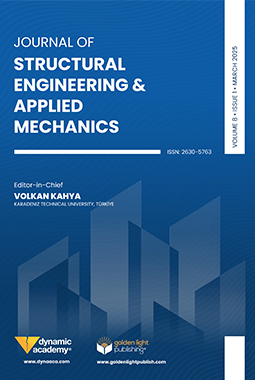ISSN:2630-5763
Journal of Structural Engineering & Applied Mechanics
ARTICLES
Ufuk Gul
In the present study, the transverse free vibration of intermediately supported nanobeams is investigated in the framework of size-dependent nonlocal strain gradient theory. Unlike the classical elasticity theory, nonlocal strain gradient theory considers the micro/nano scale effects in mechanical analysis of size-dependent structures. The potential and kinetic energies have been derived for the nanobeam model and the Ritz method has been used to determine the natural frequencies of intermediately supported nanobeams. A cantilever nanobeam model with intermediate support is considered in the analysis. By changing the position of the intermediate support, dimensionless vibration frequencies of the nanobeam model have been obtained. Obtained results from the present nonlocal strain gradient theory showed that hardening or softening material responses have been observed according to the classical elasticity theory depending on the magnitude of the material length scale parameter and nonlocal scale parameter. This mechanical behavior can provide an advantage to designers while modeling the micro/nanostructures. Present results can be used for the design of nano-sensors, nanotube-based resonators, and oscillators.
https://doi.org/10.31462/jseam.2022.02050061
Uğur Emre Temelli
Cüneyt Öngören
Barış Sayın
This study aims at examining the possible causes of the brittle collapse of a tertiary air duct system under vertical loads. Problems related to the design and construction stages were examined. The entire process was illustrated using a tertiary air duct case study in a cement plant. In the plant, the tertiary air duct collapsed without any earthquake, blast, or impact effects. The current study includes a field study, examination of an original/revised design project, and numerical simulation. In the first stage of the study, the existing state of the collapsed system and its compliance with static and mechanical projects were examined. Secondly, a two-dimensional finite element analysis was performed to determine project eligibility. The causes of the system were determined based on the data obtained in the former stages. The results showed that the causes of partial collapse included project errors, construction faults, and project incompatibilities.
https://doi.org/10.31462/jseam.2022.02062076
Huseyin Cilsalar
Seismic base isolation is an effective way of protecting structures against seismic loads and is very effective in terms of both collapse mitigation of structures and protection of non-structural elements under severe ground shaking. In this study, the structural demand of base-isolated three- and four-story steel moment-resisting frames is determined in case of a fire event followed by an earthquake, and compared with the results of fixed-base frames, which have similar geometry, load, and seismic hazard for a location in California. Four compartments are selected as possible locations for fire events in each building, and beams and columns in those compartments are exposed to a representative temperature increase in time, which includes a cooling phase as well. Maximum, minimum, and residual axial force, and moment demands on elements of the fire compartments, and drift demand of structural frames on the first and second floor, where the fire is assumed to occur, are determined and compared. Results are given in terms of parameters of three-parameter log-normal distribution, hence fragility curves can be constructed for each response considered in the study. Seismic isolation is effective in reducing both maximum and residual drift demand of the frames, and axial force in the beam element for each compartment considered. Fixed-base frames have 20% more maximum axial load on beams. Beam and column elements in the four-story configuration are under relatively more moments in case of a fire, while the performance of three-story frames depends on the location of the assumed fire.
https://doi.org/10.31462/jseam.2022.02077095
Betül Üstüner
Erkan Doğan
Metaheuristic algorithms inspired by natural phenomena are frequently used in solving optimization problems recently. Just as every problem has its characteristics, every algorithm has its unique structure. Therefore, problem-specific algorithm selection is an important issue. In addition, metaheuristic algorithms are very open to development. Therefore, improved/modified versions of algorithms are common. Working with benchmarking problems and engineering design problems is the best way to compare the performance and reliability of metaheuristic algorithms. In this study, the performances of firefly (FA), particle swarm optimization (PSO), bat algorithm (BA), ant colony optimization (ACO), glow worms (GSO), and hunting search (HuS) algorithms are compared. An enhanced version of the firefly algorithm (RFA) is also recommended and included in the comparison. A benchmark and five engineering design problems were selected for comparison purposes. All algorithms are set to twenty thousand iterations. The results show that the metaheuristic algorithm that gives the best results varies according to the nature of the problem. Moreover, although it does not change the ranking of the algorithm that gives the best result according to the problem, it shows that RFA gives better results in every problem than FA.
https://doi.org/10.31462/jseam.2022.02096116


